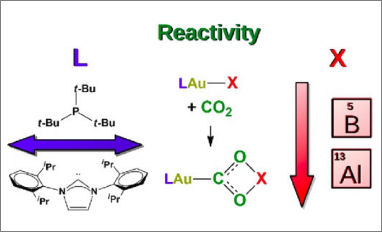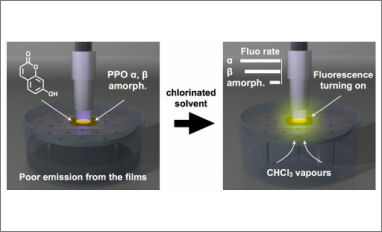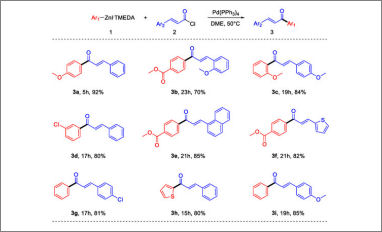
 In this work we computationally investigate the reaction of carbon dioxide with [LAuX] (L =phosphine, N-heterocyclic carbene (NHC); X = Al(NON), B(o-tol)2) complexes to get insights into the Al/B anionic and gold ancillary ligand effects on the Au-Al/B bond nature, electronic structure, and reactivity of these compounds. The Au−Al and Au−B bonds have both an electron-sharing nature, with the diarylboryl gold complexes displaying a more polarized Auδ+−Bδ− bond. The gold ligand (phosphine or N-heterocyclic carbene) has a negligible electronic effect on the Au−X bond, consistently with a radical-like reactivity of the complexes with carbon dioxide, which favors the gold-aluminyl over the gold-diarylboryl complexes.
In this work we computationally investigate the reaction of carbon dioxide with [LAuX] (L =phosphine, N-heterocyclic carbene (NHC); X = Al(NON), B(o-tol)2) complexes to get insights into the Al/B anionic and gold ancillary ligand effects on the Au-Al/B bond nature, electronic structure, and reactivity of these compounds. The Au−Al and Au−B bonds have both an electron-sharing nature, with the diarylboryl gold complexes displaying a more polarized Auδ+−Bδ− bond. The gold ligand (phosphine or N-heterocyclic carbene) has a negligible electronic effect on the Au−X bond, consistently with a radical-like reactivity of the complexes with carbon dioxide, which favors the gold-aluminyl over the gold-diarylboryl complexes.
 Congratulations to our Ph.D. student Cosimo Micheletti and to our grant holder Francesco Ventura for their scientific publication entitled “Nanoporous-crystalline and amorphous films of PPO including off-on vapochromic fluorescent 7-hydroxy coumarin guests” in Polymer journal. The study examines the preparation of nanoporous-crystalline and amorphous films of poly(2,6-dimethyl-1,4-phenylene)oxide (PPO) containing 7-hydroxy coumarin (i.e., umbelliferone) for the detection of chloroform vapours.
Congratulations to our Ph.D. student Cosimo Micheletti and to our grant holder Francesco Ventura for their scientific publication entitled “Nanoporous-crystalline and amorphous films of PPO including off-on vapochromic fluorescent 7-hydroxy coumarin guests” in Polymer journal. The study examines the preparation of nanoporous-crystalline and amorphous films of poly(2,6-dimethyl-1,4-phenylene)oxide (PPO) containing 7-hydroxy coumarin (i.e., umbelliferone) for the detection of chloroform vapours.
 Stabilized Arylzinc Iodides in Negishi Acylative Cross-Coupling: A Modular Synthesis of Chalcones.
Stabilized Arylzinc Iodides in Negishi Acylative Cross-Coupling: A Modular Synthesis of Chalcones.
Stabilized arylzinc iodides, synthesized by direct insertion of zinc into the corresponding halides, were used as nucleophiles into an acylative Negishi coupling reaction to synthesize chalcones. The reaction conditions were optimized to afford optimal results on a model reaction and then applied to synthesize nine compounds. Esters, chlorides, electron-rich, electron-poor and sterically hindered substrates are well tolerated and even heteroaryl derivatives can be synthesized.
 Lipomyces starkeyi: una cell factory per la produzione di biodiesel di nuova generazione da canne giganti infestanti. Quarto appuntamento con il nuovo progetto DSCM di comunicazione della scienza nato dalla collaborazione con Microbiologia Italia. L’articolo divulgativo del mese di aprile è stato realizzato e curato dal Dott. Nicola Di Fidio. La transizione da un’economia basata sulle risorse fossili ad una bioeconomia è un obiettivo globale attuale volto a contrastare alcune importanti problematiche, come i cambiamenti climatici e l’inquinamento ambientale; e per ridurre la dipendenza delle attività antropiche dalle fonti fossili.
Lipomyces starkeyi: una cell factory per la produzione di biodiesel di nuova generazione da canne giganti infestanti. Quarto appuntamento con il nuovo progetto DSCM di comunicazione della scienza nato dalla collaborazione con Microbiologia Italia. L’articolo divulgativo del mese di aprile è stato realizzato e curato dal Dott. Nicola Di Fidio. La transizione da un’economia basata sulle risorse fossili ad una bioeconomia è un obiettivo globale attuale volto a contrastare alcune importanti problematiche, come i cambiamenti climatici e l’inquinamento ambientale; e per ridurre la dipendenza delle attività antropiche dalle fonti fossili.



